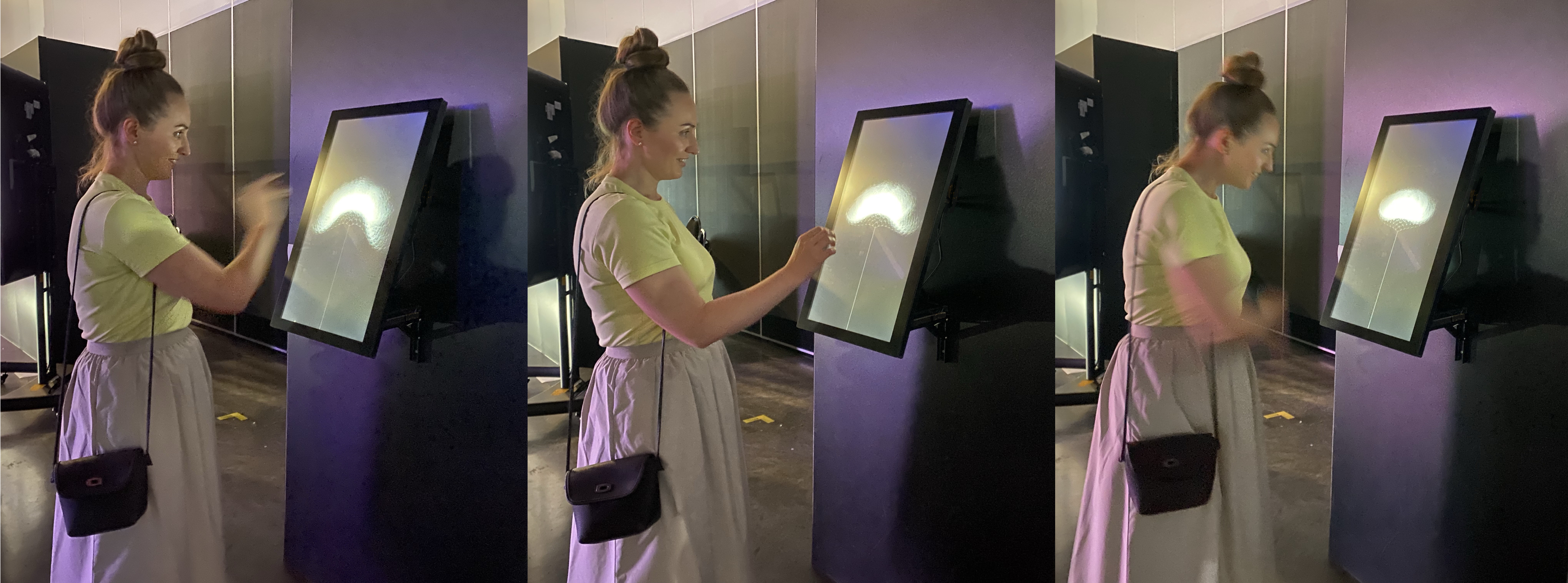Sensitive Floral
Exploring Fractal Tree Data Structures with Grid Computation in Real-Time Generative Graphical System for Mimic the Reactive Characteristics of Mimosa Pudica
"Sensitive Floral" is an interactive, generative artwork that ventures into the exploration of a unique generative system, biomimetically emulating the reactive behaviors of the Mimosa plant. By synthesizing the complexity of fractal tree data structures with the Cellular Automata mechanisms of grid computations, the artwork elegantly mirrors nature’s adaptive and responsive traits. The interactive interface allows users to initiate a ripple of movement by simply touching the screen, triggering a cascade of changes across thousands of leaves, akin to the group leaf movements observed in Mimosa. The system, instantaneously detects which branch of the tree structure on the touch screen is being externally triggered. It then notifies the grid calculation system, based on the Cellular Automata mechanism, to generate parameters for angle gradients of closing behavior between branches. These parameters are applied in real time to the image generation system of the floral structure, altering the overall appearance of the flower. The flower shaping heavily employs the recursion mathematical mechanism. Through a set of geometric relationship designs, a concept like cell division is used to grow the next branch. In the iteration process, two characteristics emerge: the development of an organizational relationship of length and angle between lines that presents an organic gradient sense, and the development of movable joints between lines that can display activity for subsequent imitation of the Mimosa pudica motion cell mechanism, demonstrating dynamic deformations.
Exploring Interactive Dynamics: Real-Time Engagement with a Virtual Floral Entit. This video captures the real-time interaction between the artwork and viewers, where touch by a finger on the virtual entity, the flower, triggers corresponding curling actions based on the cellular automata mechanism within fractal tree data structure. The flower responds to various stimuli with unexpected formations, offering a complex range of expressions beyond simple opening and closing. This interactivity invites viewers to explore the flower's form and reactions in their own unique way, highlighting an elegant process of gradual transformation.
Interaction Dynamics: fractal tree Structures with embedded grid computing mechanism. This video demonstrates the combination of fractal tree data structure and grid computing like cellular automaton mechanism, and shows the local information exchange model. The dynamic interaction between each branch and the outside stimulus is highlighted by the movement visible in the top bar of the video, where green dots represent touch-activated responses, illustrating the real-time dynamics of the artwork responding to user interaction.
Branching Logic: Visualizing the Hierarchical Network of 16382 Nodes. This video elucidates the intricate details of the artwork's fractal tree structure, which has 13 iteration time, producing a total of 16,382 branches. Each branch is uniquely identified by a numerical code—depicted in blue within the video—which corresponds to its position within the hierarchical tree structure. These identifiers are crucial, as they define the relational organization between each branch and its place in the overall system. In the algorithmic process, these identifiers are used to set up communication protocols for information exchange between adjacent nodes, including a parent branch from the preceding iteration layer and two offspring branches in the subsequent iteration layer. This framework facilitates the development of chain-reaction emerging behaviors across the entire structure.
Animating the Growth of Floral Forms: An Experimental Animation through Generative Imaging Systems. This video showcases experimental animation generated by a derivative imaging system, employing mathematical iterations to depict the growth process of flowers. It further utilizes recursion mechanisms and the geometric relationships of image lines for dynamic variations in floral forms. The background music is collaboratively composed by Yi Ping Yang and James Giroudon, enhancing the audio-visual experience. Particularly during zoomed segments, the video highlights the biomimetic beauty of symmetry and complexity achieved through recursion and fractal tree data structures.

Developmental Pathway of Sensitive Floral. This document delineates the developmental pathway of the "Sensitive Floral" project, encapsulating both conceptual foundations and technological evolution. It provides a systematic representation of the project's phases, elucidating the operational mechanics of the system alongside the progression in visual articulation. Through a methodical arrangement of images, the document descripts the project's evolutionary process, blending biomimetic aesthetics with generative design and adaptive system functionalities.
---
在仿生媒體(Biomimetic Media)領域(Weibel, 2023),近年來發展了以電腦運算系統模仿生命運作機制的創作表現方向,並藉由以感測器與外在實體世界的觀者進行對話,讓這些仿生演算法被設計除了再現生物的型與特徵外,更能與觀者進行直覺的互動。例如,衍生設計(Generative Design)和代理機制(Agent Mechanisms)等概念發展的仿生演算法(Biologically Inspired Computing),近年來更被提出許多作為人工生命(Artificial Life)的藝術表達的創作發展(Ohlenschlager et al., 2023),蔚為當代藝術重要的發展面向。
延續本人先前的創作《Hybrid Dandelion》(Huang & Hsiao, 2019),在《Sensitive Floral》 作品中,我借鑑了數學細胞自動機(Cellular Automata)產生突顯行為的特質,將其網格計算(Grid Computing)機制建構於二元碎形樹(Fractal Tree)資料結構發展的衍生設計圖像系統中。建構一種樹枝結構與其相鄰分支(包括與迭代層次中上一層的父母輩分支、平行迭代層次中的同輩分支,以及下一層迭代中的子女輩分支)之間可調適性的交互關係。這樣特殊的樹狀結構,驅動內部的區域性的資訊交換(Local communication),以此同步展現與外部觸發的交互關係。透過這樣的觸發性與擴散性的細胞運動反應機制(Diffusive Cellular Motion Response)的研究探索,發展出貼近在含羞草(Mimosa pudica)在生物學研究上,所發現葉片在集體動態反應中的細胞運作機制 (Hagihara et al, 2022)。
此外在參數設計應用在數據驅動蒲公英圖像生成的規則設計中,從二元碎形樹與歸遞機制研究,發現單一規則參數的改變,影響迭代性的整體造形調適性的連動變化,這樣自我組織性的交互效應,由下而上猶如細胞分裂般的影響,發展出多樣性仿生紋理。從遞迴、對稱性、碎形樹等演算法的應用,以及參數與規則設計等機制,發展仿擬花意象與美感表現,強調在「形態異變」、「花開」、「生長」等花的意象視覺表現。在衍生系統的設計中,依照靜態與動態美感的標準,重新定義了線條的表現參數(粗細與透明度)與其迭代階層的狀況,建構關聯性的規則。並在動畫的生成、動態視覺的表現上,重新以視覺表現的角度增加了程式的運作機制,以此發展仿生美感。
《Sensitive Floral》 是一件可互動的即時衍生圖像裝置,企圖建立虛擬人工生命(Artificial Life)圖像內容與賞者即時互動,透過手指觸摸觸控螢幕上樹狀結構的枝節,引發由網格運算(Grid Computing)產生的反應機制,模仿生物 (參考生物學中含羞草的動力細胞的運作)具調適性的連續性動態行為。背後是利用數學細胞自動機(Cellular Automata)網格運算的機制設計,探索樹枝與相鄰樹枝節點的群動性突顯行為(Emergent Behaviors)的動態表現,並且著重在將仿生概念與外部使用者觸覺互動的資訊表現,以此發展融合性的互動情境。
該創作將演算法自主調適性的動態過程,視覺化表現,模仿含羞草(Mimosa Plant)動態細胞間的反應行為。通過將碎形樹(Fractal Tree)數據結構的複雜性與單元自動機(Cellular Automata)的網格計算(Grid Computations)機制相結合,以人為的設計方法將含羞草生物性的群體葉片運動機制,創造出自然世界不存在樹狀結構上的樹狀連鎖動態反應。這樣的互動體驗(Interaction Design)是透過觸摸屏幕,提供觀者以手指輕觸葉片,來啟動一系列的細胞運動反應機制。這件作品以系統運算的機制設計為基礎,運用衍生式規則和參數設計來探索非傳統的視覺圖像表現。從對生物形態的觀察和模仿,創作出模擬和再現植物的外形和生長行為的演算法,作為人工生命藝術 (Artificial Life Art) 的一種實踐。從遞迴(Recursion)、碎形樹(Fractal Tree)、L-system的運算結構和機制設計中,發展出仿擬生物的生長型態和視覺紋理,創建出與參觀者互動的機制。通過結合演算法的規則機制和參觀者的互動和資訊擷取,創造出能夠即時產生數據驅動藝術的視覺圖像的表現。
All images and videos courtesy Scottie Chih-Chieh Huang and The BioLogicDesign Lab.